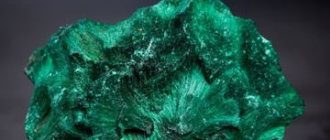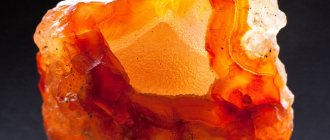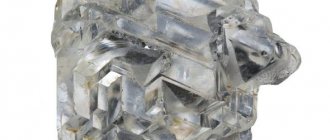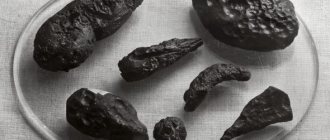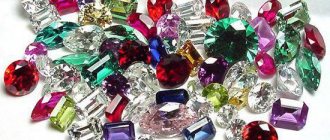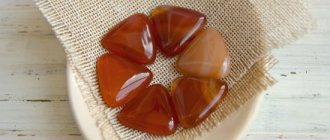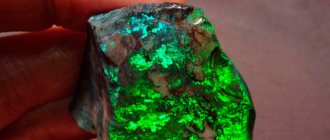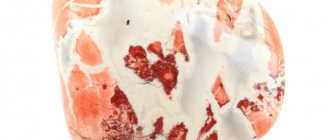There are many mysteries associated with this stone. It is considered semi-precious, but costs the same as a diamond and even more. The natural reserves of such gems are kept secret, so no one will say when they will run out. The color of the mineral cannot be described in one word because it changes depending on the lighting. The name of the “stranger” that all fashionistas in the world dream of is Sultanite.
Description and uniqueness of the stone
Sultanite (diaspora, thanatarite, zultanite) is a symbol of Turkey, a rare semi-precious stone. It has an unusual quality that only 1% of earth's minerals have. Like alexandrite, it can change color, but it has a richer and more varied palette of shades.
Under different lighting angles, the same stone shimmers with yellow, amber, crimson, brown, and rich green shades. Plus, it gives off lots of sparkling highlights. By purchasing a product with a diaspora, you can get the effect of several decorations that can be easily combined with different wardrobe items.
It is transparent, like sapphire or ruby, but very fragile. The chemical composition of sultanite includes two main components - corundum (75%) and water (25%), therefore mineralogists call it watery corundum.
Although corundum is known for its hardness, this gem is unusually fragile. Due to increased fragility, up to 97% of the original weight of nuggets is lost during processing and mining. The fragility of sultanite is explained by the fact that it contains hydrogen ions, which destroy the atoms of the crystal.
In addition to fragility, the mineral has the following physical characteristics:
- Hardness – 6.5/10 on the Moss scale.
- Density – 3.5 g/cm3.
- Pearlescent or glassy luster.
- Opaque or translucent.
- Color - from white, colorless, pale yellow to pink, lilac, brown and all kinds of shades of green.
According to cutters, such a stone is collected from the surface of the Earth once every 5 years, so the mineral is considered rare and is sold at the price of cut diamonds.
Physico-chemical characteristics of diaspore
Chemically, the diaspore consists of 2/3 aluminum oxide and 1/3 water; among the impurities it contains iron, chromium, manganese and gallium.
In addition, there is a natural polymorph with an identical composition, which is known as boehmite. Diaspora crystals have an orthorhombic system; they are plate-like or columnar in shape, sometimes in the form of needle-like formations. Sometimes the mineral is found in the form of a solid granular mass. The diaspore is colored white or gray with a yellowish, pinkish, greenish tint, which depends on the presence of certain inclusions in the sample. For example, iron compounds give a yellowish, brown, or brown color. The high content of manganese oxide gives the mineral a pink or red tint, while chromium gives the crystals a greenish color. Sometimes samples are characterized by an alexandrite effect: when the lighting changes from daylight to electric, the color of the stone changes from yellowish-greenish to pinkish-yellowish.
Diaspora hardness on the Mohs scale is 6.5-7.0. Specific gravity 3.10-4.01. Refractive index 1.702-1.756. Birefringence 0.054. It does not melt when heated and is insoluble in acids.
— Advertising —
Crystals are transparent or translucent. They have perfect cleavage. When broken, they are conchoidal, with a glassy or pearlescent sheen.
Diaspore is a very brittle stone, and when heated, it turns into corundum.
Origin of the mineral
Sultanite is known in the world as the Turkish stone that changes color. In fact, the mineral was first discovered 200 years ago in the Urals near the village of Kosoy Brod. The gems were found by chance while mining iron ore. They were given the name “ferruginous kyanite,” but this name did not stick.
The specimens found in Russia were so small that they could not be cut, so the find was not given much significance. Joseph Tanatar, a Russian professor, Doctor of Geological and Mineralogical Sciences, began studying the unfamiliar stone. He compiled a detailed description of the mineral. In honor of the talented scientist, the gem was named thanatarite.
The French geologist Rene Justa Gaüy became interested in the Ural gem. He discovered that the chameleon stone cracked when heated. For this quality, he dubbed the mineral diaspore, which translated from ancient Greek means “crumbly.” The name has taken hold in European countries, where it is still considered the official name of the mineral.
For two centuries, thanatarite remained exclusively the property of mineralogists and collectors, but in the 70s of the twentieth century, in one of the mountainous regions of Turkey - Anatolia - a deposit of diasporas of rare beauty was found. At first, the sultans' stone was mined illegally and smuggled to Europe.
Later, Millennium Mining Co. received a mining and export license. To this day, it remains the only official supplier of raw diaspora to other countries.
The owner of this concern, Murat Akgun, decided to perpetuate the famous dynasty of 36 sultans, which ruled Turkey since the 13th century. He awarded the stone, which changes color depending on the light, the telling name sultanite. In Turkish it is pronounced zultanit.
Diaspora history
Diaspore (literally translated from Greek as “dispersion”) is the most common name for the mineral and the oldest.
This name was given by a crystallographer from France, R. J. Gayuy, in 1801. In Russia, beyond the Urals, this stone was also called ferruginous kyanite. Advertising - Continued below
The stone has several more or less well-known names: thanatarite (in honor of the famous geologist Tanatar Joseph Isaakovich), sultanite or zultanite (high-quality stones mined in Turkey), empholite.
Faceted sultanites (diasporas)
Where is sultanite mined?
High-quality samples of zultanite, which have jewelry value, are mined in Turkey. Large deposits of such minerals are located near the village of Selimiye in the Ilbir Mountains. The stone is fragile, so when mined, 97-98% of gems go to waste. Only 2-3% of the total amount of mined raw materials turns into sparkling jewelry after processing.
The Turkish government does not disclose the natural reserves of sultanite on its territory. Nobody knows how many there are, so purchasing such a stone is considered a profitable investment.
Sultanites are found in Europe. There are small deposits in Norway and Hungary. Diaspore is mined on the island of Madagascar. In Africa, mineral deposits were discovered in the Kalahari Desert. The USA also has natural reserves of these gems. They are located in Massachusetts.
In Russia, the development of such stones is carried out at the Kosobrodskoye and Saranovskoye deposits, located in the Urals. The many-sided mineral is also mined in Yakutia. It is found in China, Australia, Azerbaijan, and Uzbekistan.
The sultanite stone is still considered rare.
The fact is that diasporas from other countries are significantly inferior in quality and quantity of shades to Turkish gems. They are processed and mounted, but due to their small size and opacity they are not considered valuable.
Deposits of diaspora and sultanite
Türkiye is home to the unique iridescent Diaspora stone. It has been known here for a long time, and was especially popular among the sultans. At an altitude of more than 1300 meters in the Anatolian Mountains, the largest deposit of diaspora was discovered - this is where the most beautiful and expensive specimens are found.
Uncut natural diasporic sultanites
The extraction process itself is very difficult: the sultanite stone is quite fragile, and up to 98% of all extracted minerals eventually crumble (either during excavations or when trying to process it).
Advertising - Continued below
In addition to Turkey, there are diaspora deposits near Yekaterinburg (where the stone was first found), in Uzbekistan, Kazakhstan, Azerbaijan, South Africa, the USA and Madagascar. In addition, sultanites are found in Greece, Hungary, Norway, China and some other countries.
Jewelry value of the stone
Turkish sultanite has been officially used for making all kinds of jewelry since 1994. Skilled craftsmen make everything from the faceted mineral, except beads and bracelets. Women choose dazzling earrings, rings and pendants made from stones that change color at different times of the day and in different lighting.
Wearing such jewelry is fashionable and prestigious. Men prefer luxurious rings that indicate the high social level and material well-being of their owners.
The bright beauty of diaspora is best set off by a silvery sheen, which is why it is set in platinum and silver. All the luxury and depth of the stone is also manifested in combination with gold. The capricious mineral does not tolerate proximity to low-grade metals. Framed with such material, it darkens and fades. This diaspora property has been used in the past to determine the authenticity of gold.
The larger the size of the stone, the more pronounced is the ability of sultanite to change color depending on the lighting.
Jewelry made from natural sultanite is an expensive pleasure. The price of such products is not affordable for every lover of precious stones; it is:
- for a ring: set in silver – from 3 to 5 thousand rubles, in gold – 9-15 thousand rubles;
- earrings: silver – 3-10 thousand rubles, gold – 15-30 thousand rubles;
- pendant: 2-4 thousand rubles. (in silver), 4-7 thousand, if the stone is inserted into a frame made of precious metal.
How to wear
Sultanite is a gem that appeals equally well to both women and men. For ladies, there is a general rule that applies to all jewelry - the older, the larger and darker the stone.
Representatives of the stronger sex, whose style is predominantly official and businesslike, can safely choose cufflinks, tie clips or rings with dark stones. Bright examples of sultanite in men's accessories are suitable for casual evening events.
When choosing an outfit for sultanite jewelry, you should opt for plain clothes, without prints or colorful colors. Cool shades are suitable for accessories made of white precious metals. Gold jewelry looks great with yellow and gold color palettes.
Regarding the proximity of other stones or products, the best partners for the sultans’ gem will be diamonds, pearls, and aquamarine. Any blue, green, black or white transparent gems are also suitable. An unsuccessful aesthetic combination would be semi-precious or ornamental minerals, as well as red-colored gems. Zultanite itself is independent, and when framed in white gold, platinum or silver it is especially luxurious.
When choosing an outfit for sultanite jewelry, do not forget that this is a chameleon stone. This means that no matter what its natural shade is, in the sun it will turn amber-brown, and in cloudy weather, in the light of lamps or at dusk - green.
Color spectrum
Thanatarites that do not contain impurities are found in nature. They are completely transparent. Such stones are not considered valuable. They are of no interest from a jewelry point of view.
Colored stones are popular and in demand:
- Pink - include manganese.
- Amber, yellow-brown - contain iron.
- Different shades of green. Such samples contain chromium impurities.
Diasporas of greenish-pink and pink-brown shades are recognized as the most valuable in the jewelry world.
Medicinal properties
This is a “young” mineral. People met him two centuries ago. In the past, healers did not use the Sultan’s stone for treatment, so Thanatarite did not have time to establish itself in alternative medicine.
Diaspora is a natural formation. In esotericism, it is believed that all minerals store the energy of the Cosmos, and therefore are able to influence health. People have yet to learn about the healing talents of the sultanite.
Today it is known that it has the following medicinal properties:
- accelerates recovery from viral infections;
- relieves pain in the spine;
- has a positive effect on the functioning of the heart;
- strengthens the immune system;
- calms, relieves depression.
Magic properties
Psychics could not ignore such a unique stone. They studied its energy and determined that the sultanite is able to foresee tragic events. The mineral senses the approach of misfortune or danger. If the owner of the stone is in danger, the diaspora cracks or becomes cloudy. In magic, the chameleon mineral is used as a predictor.
Sultanite is not used for mystical rituals that can harm a person. He does not perceive negative energy and is unable to transmit it. This is a talisman for people who are creative. It gives inspiration and awakens bright thoughts. Zultanite is suitable for artists, poets, musicians, actors, playwrights.
Mystical properties of the sultanite stone:
- Develops intuition. Strengthens and cleanses the human aura.
- Attunes to a philosophical perception of life. The stone is suitable for meditation. It calms you down, makes you forget about adversity and everyday trifles, and think about the eternal. To come into harmony with nature, you need to put it in front of you and peer into the depths of the mineral for 15 minutes.
- Becomes a shield from energy vampires.
- Helps scientists make discoveries. Strengthens self-confidence and gives impetus to daring endeavors.
- Enhances supernatural abilities - helps fortune tellers and sorceresses look into the future. To find out what fate has in store for a person, a special ritual is performed. You need to continuously look deep into the iridescent crystal for several minutes, holding it in your hands. Then the sorceress mercilessly throws the mineral into the fire. The stone is cracking. The fortune teller uses the cracks to determine the future.
- Sets you up for positivity. If a person is feeling sad, he can gently rub the stone. This will improve your mood and dispel sad thoughts.
In Europe and the USA, sultanite is equally popular among women and men. For representatives of the stronger sex, it is valuable because it develops fortitude. This stone helps girls make informed decisions dictated not by the heart, but by the mind.
It is believed that the magical properties of the stone are most strongly revealed if expressed by the numbers 7 and 5, that is, the happiest mineral will be a mineral weighing 7.77 or 5.55 ct. Silver enhances the predictive abilities of sultanite, so psychics use minerals set in this metal.
Magic and lithotherapy
Sultanite is very young, if we count from the moment of his official appearance to the world. However, esotericists have already managed to study this gem, determining the magical abilities of the mineral:
- Stone loves creative people. It doesn’t matter what field of activity a person is involved in, the main thing is that he has charisma and talent, even if hidden from himself. The mineral will bring inspiration to the owner, the ability to act extraordinary in any situation.
- Talisman of pessimists. Established bores and skeptics will be able to rebuild their emotions and thoughts in an optimistic way.
- A powerful amulet. The Sultans' stone protects a person from any energetically negative factors (damage, love spell, evil eye) and bad people.
- Implementer of ideas. With the help of the diaspora, any idea and goal will be within your reach. The nugget will not let you leave the job you started halfway in order to take on something new.
For those whom nature has not endowed with creative abilities or any talents, sultanite will also be useful. The pebble will help the owner to look at reality philosophically, think about the meaning of his existence and find non-standard answers to difficult questions.
Do you know that in the past, fortune tellers used non-jewelry crystals to predict a person’s fate. To do this, the one who wanted to look into the future held stones in his hands, after which the witch threw them onto hot coals. Under the influence of temperature, the crystals cracked, and the shamans determined the fate of a person from the cracks.
Modern fortune tellers also use cracked diaspora to predict the future owner. It is also believed that a gem set in silver exhibits maximum magical power.
As for the healing capabilities of the nugget, lithotherapists did not find in it any special ability to heal the body. It is only known that zultanite helps with mild headaches, slightly alleviates the body’s condition during colds, and also helps to get out of depressive states.
Bracelet
If the stone cracks or splits without previous mechanical stress, this may signal future financial or health problems.
What stones does it go with?
Sultanite is a “livable” mineral. It shimmers in different colors, so it can be combined with many stones. The only condition is that you cannot combine diasporas and costume jewelry in one product. Such proximity will spoil its appearance. It will lose its shine and become cloudy.
Compatibility of sultanite with other stones:
- high - with pearls, diamonds, onyx, other green, white, black minerals and transparent crystals;
- medium - with agate, turquoise, aquamarine, as well as purple, blue, blue stones;
- weak - with ruby, tourmaline and other minerals of red shades.
Which zodiac signs are sultanite suitable for?
Astromineralogists have determined that sultanite belongs to the element of Fire, therefore it is most suitable for fire signs and comes into conflict with those who, according to the horoscope, belong to the element of Water. This does not mean that it cannot be worn by those whose zodiac sign is Pisces, Scorpio or Cancer. Thanatarite will not harm them, but it will not improve their fate either.
Interaction of sultanite with different zodiacal constellations:
- Aries, Sagittarius, Leo - will reveal creative abilities, sharpen the “sixth sense”, strengthen family and friendships, and relieve excessive sentimentality. Wearing this mineral will help representatives of such signs soberly assess current events and recognize the true intentions of others.
- Gemini, Libra, Aquarius - will bring stability into their lives, make them think about the meaning of existence and the correctness of the chosen path. If someone harbors a grudge or is hatching plans for revenge, then the Sultanite will calm these passions and help forgive the offender. Having found peace of mind, a person will feel healthy and full of strength. He will have ambitious plans.
- Capricorns, Virgos, Taurus - will improve your personal life, help you find a soul mate, make a person more sociable and friendly, bestow wisdom, teach you to avoid conflicts.
- Scorpios, Pisces, Cancers - the Sultanite will have a calm relationship with them. The stone will give water signs confidence and teach them to look at life with optimism.
How to distinguish from a fake
Large, high-quality specimens of natural sultanite are rare, and the demand for the unusual mineral is constantly growing. Chemical engineers set out to solve this problem. They created a synthetic analogue of the chameleon mineral - hydrothermal sultanite. It was obtained by aging alumina hydrate gel. To produce the double, natural raw materials are used - crumbs of natural gems.
Russian specialists from the Rusgams company have developed and patented a technology that has made it possible to create another artificial analogue of such a stone - glass ceramic. It is produced on the basis of silicon dioxide and aluminum oxide at a temperature of 1700 °C. Using the same method, it was possible to synthesize 10 varieties of stones with an alexandrite effect.
In appearance and physical qualities, it is an exact copy of a natural mineral, but its strength is higher, and therefore it is much easier to process such material. Making synthetic prototypes is cheaper than mining natural nuggets.
Currently, most jewelry is made from artificial mineral, which has no healing or magical properties. Natural and synthetic samples differ from each other in color transitions, but only a gemologist can detect such a discrepancy.
It is impossible for an ordinary buyer without special equipment to distinguish a fake from a real stone. By law, the manufacturer is required to indicate the origin of the mineral on the price tag, but not all jewelry manufacturers comply with this requirement.
Two ways to distinguish natural sultanite from “fake” one:
- Marking. Carefully examine the stone, if the letters are written on the tag: “g/t” - short for hydrothermal or glass-ceramic, it means they are synthesized artificially.
- Price. Natural sultanite is an expensive stone. The cost for 1 carat reaches $100, which is comparable to the price of a diamond. If a seller offers jewelry with a diaspora, which costs much less, then this is a skillful fake. Hydrothermal twin and glass ceramic are valued about the same as topaz and garnet.
How to care for stone
Natural sultanite is a capricious stone. Due to its high fragility, it will crack from any careless movement accompanied by a fall. It should not be handled with dirty hands; greasy marks will be left on it. It will no longer be possible to remove such marks.
Zultanite requires delicate handling. If you have jewelry with this mineral or an unset stone (which seems doubtful), follow these care rules:
- Wash periodically in cool water and mild soap.
- Do not drop or subject to mechanical shock.
- Do not clean Thanatarite with rough sponges.
- Do not use household chemicals to remove contaminants that appear on the mineral.
- Do not expose sultanite to sudden temperature changes. Do not take it out of a warm room into the street if it is freezing there. Leave the chameleon stone at home.
- Do not heat the diaspore - it will burst.
- Do not allow acids or solvents to come into contact with the surface of the mineral.
- After washing, wipe the gem with a soft cloth. This will restore shine.
To prevent the gem from falling apart, keep it in a soft box, separate from other jewelry and minerals.
In Turkey, these stones began to be mined and processed only half a century ago, but a legend has already developed about their origin. It says that iridescent gems were worn exclusively by sultans, who presented such jewelry to their wives and concubines. Although this is a beautiful myth, sultanite is truly a strange mineral. It is a pity that it is almost impossible to buy the original. Instead of natural stone, its synthetic “brothers” are often on sale.
Care instructions
It is not for nothing that Sultanite is called a diaspora, that is, “splitting.” This mineral requires especially careful care, as it is incredibly fragile by nature. Any careless movement accompanied by a blow or fall will destroy such a rare and expensive gem. Therefore, sultanite must be worn carefully and protected as much as possible from mechanical damage, as well as from grease, fingerprints, sweat and household chemicals.
Important! Sudden temperature changes are contraindicated for natural sultanite, otherwise the stone will crack or completely crumble.
Otherwise, caring for jewelry is quite simple, although it requires some delicacy. Clean the mineral with cool water and a light detergent. Wipe with a soft cloth. Storage only individually, in a box with soft walls or in a bag.




